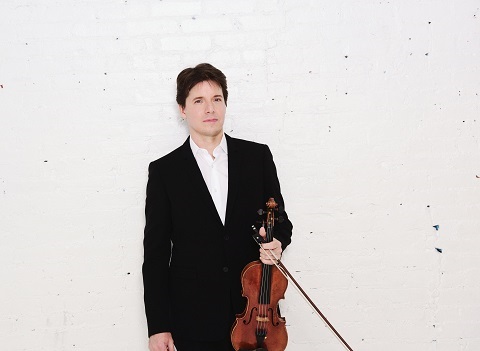
 United Kingdom BBC Prom 40 – Mendelssohn, Saint-Saëns, Bridge, Beethoven: Joshua Bell (violin/director), Academy of St Martin in the Fields, Royal Albert Hall, London, 12.8.2018. (CS)
United Kingdom BBC Prom 40 – Mendelssohn, Saint-Saëns, Bridge, Beethoven: Joshua Bell (violin/director), Academy of St Martin in the Fields, Royal Albert Hall, London, 12.8.2018. (CS)

Mendelssohn – A Midsummer Night’s Dream, Overture Op.21
Saint-Saëns – Violin Concerto No.3 in B minor Op.61
Bridge – Lament (Catherine, aged 9, ‘Lusitania’ 1915)
Beethoven – Symphony No.4 in B flat major Op.60
One thing that was immediately and undoubtedly evident to the large numbers who had flocked to the Royal Albert Hall on Sunday afternoon to hear the Academy of St Martin in the Fields under their director Joshua Bell, was the real pleasure that the orchestral members clearly derive from playing for and with Bell. In this varied Prom, there was a clear sense of communal purpose and understanding, unwavering attention to detail, and consistent freshness and vigour.
Bell is a dynamo, whether in the leader’s seat, or performing as soloist, and his physical engagement with the music is obviously inspiring. His bow, when it’s not dancing or gliding on his violin strings, sweeps through the air with gestures of grace and economy; he is constantly making eye contact with his players, lifting his violin high, leaning forwards, guiding, encouraging.
The violins’ elfin staccatissimo quavers at the start of Mendelssohn’s overture to A Midsummer Night’s Dream fizzed excitedly – meticulously precise and airily delicate despite the di molto pace – propelled by mischievous viola pizzicatos. And, the energy only escalated with the blaze of colour exuberantly announced by full woodwind and brass, and the lower strings’ galloping rhythms. The woodwind showed that they could match the strings for exactitude, while the untroubled scales of the sweet second theme fell and rose silkily. The ensemble was excellent – just a few very occasional wobbles – and through the exaggerated dynamic contrasts and varied motifs, there was no let-up in racing energy. The braying calls were good-natured but there was darkness in the sparsely textured, minor-key development section, where the horns’ brief but forthright interjections acquired an edgy, ominous quality. Bell and the ASMF charmingly captured the vivacity and drama of Shakespeare’s woodland fantasy.
The Academy have embarked upon a project to record all of Beethoven’s symphonies, and judging from this athletic reading of Beethoven Fourth Symphony the cycle will offer much to enjoy. The brightness of the ensemble sound was noteworthy and even though vigour and punch sometimes took priority over polish, woodwind contributions were finely etched and there certainly no lack of precision. I felt the presence of Mozart’s honest emotion and Haydn’s humour. The Allegro vivace had me on the edge of my chair, and the forward momentum and drive must surely have swept up anyone suffering from mid-afternoon languor. The Adagio was beautifully and embracingly warm, with wonderfully pungent and reedy woodwind contributions and a compelling forward sweep: perhaps too forthright for some, but confident and purposively articulated enough for me – especially in an auditorium of this size. The Allegro vivace scherzo really zipped and slithered, with shoulder-twitching accents and syncopations, and a brazen swagger, of the kind the Beethoven does best, and given the fairly small size of the ensemble they conjured an impressive aural sweep – even bombastic brashness in the Allegro ma non troppo finale.
Though Bell evidently wanted to proceed with unbroken movement through the movements, the Prommers’ coughing and insatiable desire to applaud every musical motif thwarted his desire. The symphony was preceded by Frank Bridge’s Lament – designed as a memorial for a tenderly young victim, whom Bridge knew personally, of the sinking of the Lusitania, and apparently composed in a single day (14th June 1915) – from which Bell also seemed to wish to proceed segue into Beethoven’s Symphony, acting as a sort of introductory prelude. He was, however, thwarted, by a slight hesitation of his own directing bow – the desire for a necessary heartfelt breath of release, perhaps – and the desperation of Proms audiences to clap every single movement of the performed works; and, in any case, the Symphony’s first movement has its own dark Adagio opening, while Beethoven’s overall harmonic and emotional trajectory treads a wholly different path. That said, the Lament was played with contemplative beauty, never sentimentalised; the divided string lines were clearly individualised and the whole texture was a sensitive but purposeful murmuring of loss – not overly doleful but replete with emotion.
It was, though, as a soloist that, perhaps not surprisingly, Bell’s talent and musicianship truly shone – in Saint-Saëns’ Third Violin Concerto, which in his hands was no mere virtuoso showpiece but a work of French delicacy complementing Spanish fire. The huge leaps up the G string at the start of the Allegro non troppo were fearlessly negotiated, and though Bell was facing away from his accompanying orchestra, the latter were unfailingly responsive to every rubato and flexible nuance, expressive yet well-marshalled – and a testament, surely, to thorough rehearsal of the sort that Bell, a soloist whose flying schedule must resemble a military timetable, surely enjoys. But, no sooner had the soloist’s challenges had been effortlessly despatched than Bell was turning to the orchestra, directing the tuttis, and even when immersed in the virtuosic flurries he could be assured of clear directional drive, particularly from celli and basses.
There was terrifically suave virtuosity – for example, the harmonics in the quasi-cadenza at the end of the slow movement which reportedly were designed to showcase the particular talents and delectations of the dedicatee, Pablo de Sarasate, and the gritty edginess at start of the final Molto moderato e maestoso which evinced a devil-may-care flamboyance and was answered by confident orchestral stamping. But, there was also wonderful gracefulness in the slow theme of the first movement – a soyeux timbre of neoclassical elegance that blossomed into Romantic ardour. Though the third movement danced fleet-footedly there was no neglect of melodic grace nor of the majesty of the second theme.
Bell’s characteristic immaculate intonation, effortless bravura and sweetness of tone is so unforced that it is easy to under-value. The second movement flowed easily and had a breathless beauty and a semplice, not just in the solo line but also in the initial watery bed of string undulations, tuneful oboe dialogues and, latterly, clarinet and flute decorative blossomings, particularly in the final episodes. Similarly, in the slow theme of the finale the muted strings played with precious delicacy and care. This was chamber music to draw in every listener from the far reaches of the Royal Albert Hall and make them feel part of the collective music-making.
Claire Seymour